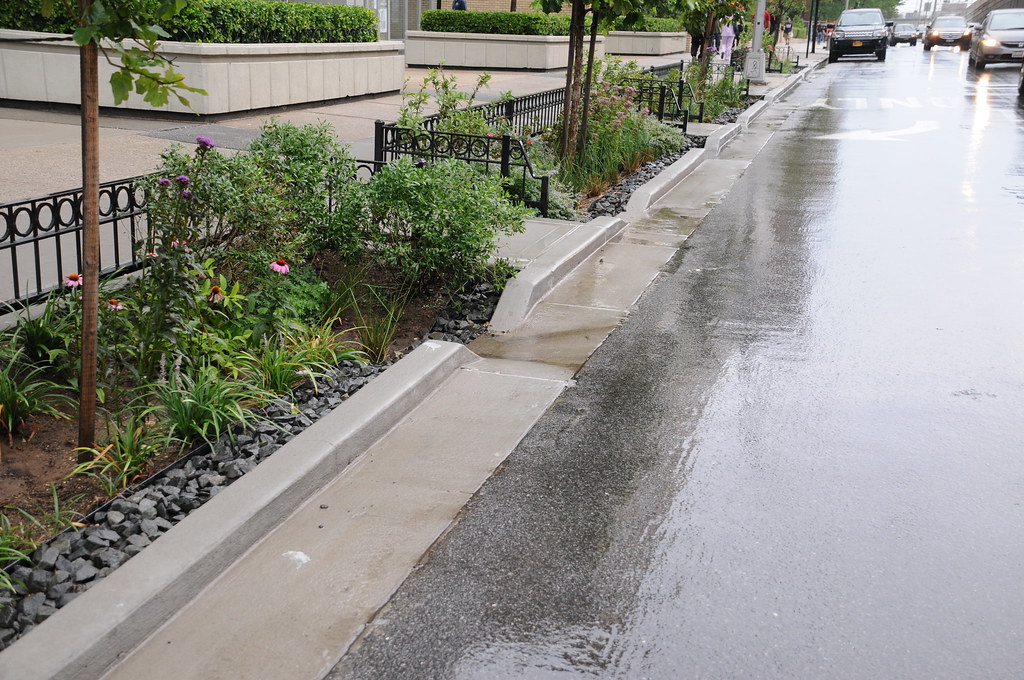
 Environmental Protection311
Environmental Protection311 Search all NYC.gov websites
Search all NYC.gov websites
Rain Gardens
Rain gardens can improve your street by reducing ponding, providing summer shade, and greening your community. Most importantly, rain gardens improve the environment by allowing rain to be naturally absorbed into the ground instead of flowing into the sewer system. We have successfully built thousands of Green Infrastructure installations, like rain gardens, across New York City.
Download the NYC Rain Gardens Brochure.
Rain Gardens in Your Neighborhood
If you have questions about rain gardens in your neighborhood, you can call our Rain Gardens Hotline at 718-595-7599 or email raingardens@dep.nyc.gov. To report a maintenance issue, please call 311 or visit nyc.gov/311.
Become a Rain Garden Steward
If you would like to volunteer to help care for rain gardens in your neighborhood, please email raingardens@dep.nyc.gov to request more information.
To learn more about the Rain Garden Stewardship Program, download the Rain Garden Stewardship Program Maintenance Manual.
Rain Garden FAQs
What do rain gardens do?
On rainy days, our sewer system has to collect the water that goes down the drain in our homes (we call it “wastewater”) and the water that falls as rain on our streets and sidewalks (we call it “stormwater”). If it rains enough, our sewers can fill to capacity and a mix of wastewater and stormwater can end up going into our local waterways (we call these events “combined sewer overflows”). Rain gardens are important because they collect and absorb stormwater before it can enter our sewer system. When we prevent stormwater from going into our sewer system, we’re reducing the amount of combined sewer overflows that enter our local waterways. Rain gardens are located in areas where they can have the greatest impact on improving the health of surrounding waterways. These gardens also help to cool temperatures, clean the air, promote biodiversity, and beautify neighborhoods.
How does DEP care for rain gardens?
We care for New York City’s expansive network of Rain Gardens citywide. We inspect them on a regular basis, as well as remove litter and sediment that stormwater may have carried in. We also pull weeds, prune trees and shrubs, and monitor plants to make sure they are thriving.
Do rain gardens attract mosquitoes?
Mosquitoes require a minimum of 72 hours in standing water for larvae development. Rain gardens are designed to drain in 48 hours or less. If your rain garden does not appear to be draining properly, please call 311 or email us at raingardens@dep.nyc.gov.
Do rain gardens prevent people from walking on the sidewalk or block driveways and building entrances?
No, We work with the Department of Transportation (DOT) to ensure that rain gardens comply with the City’s requirements for pedestrian access and safety.
Do rain gardens remove parking?
Most rain gardens are installed in the sidewalk and are designed to have no impact on parking. When larger rain gardens are proposed, we work with DOT work to minimize parking impacts.
Do tree roots crack the sidewalk or interfere with utility lines?
During design and construction, we work with utility companies to ensure that rain gardens will not directly interfere with existing underground and above-ground utility service lines. Older tree roots can break sidewalks because the tree pit is not large enough for the tree roots. But the City’s standard rain gardens are at least 10 feet long, which gives tree roots plenty of space to grow.
Contractors have been working on rain gardens in my neighborhood and there are tree guards but no plants. Why are these sites still unfinished?
Construction on rain gardens may begin at different times throughout the year. However, planting of the rain gardens must occur during the spring or fall season when conditions are optimal for planting. Construction on these rain gardens may have begun earlier in order to be ready for the next appropriate planting season.



